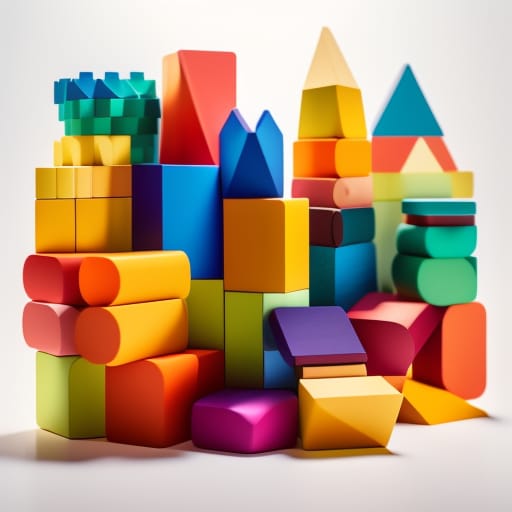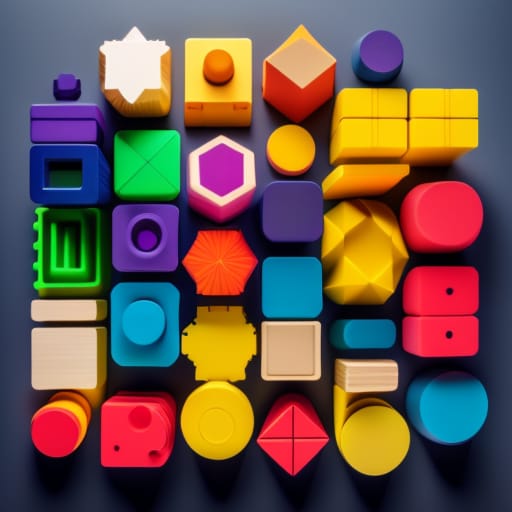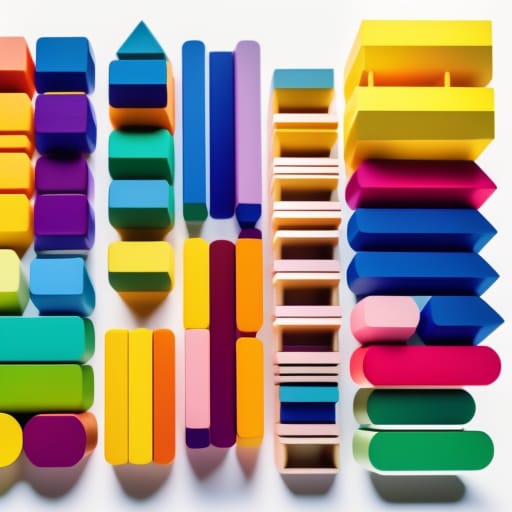Unit blocks have been a staple of early childhood education for over a century, providing a versatile open-ended toy to support cognitive, motor, and social-emotional development. As a leading manufacturer of educational wooden toys, Melissa & Doug offers high-quality and innovatively designed unit blocks suitable for children as young as toddlers up to the early school years.

Overview of Unit Blocks and Melissa & Doug
Unit blocks refer to sets of proportionally sized wooden blocks of varying shapes – such as cubes, rectangles, arches, and cylinders – that allow for building and stacking. Originally created by early childhood education pioneer Caroline Pratt in the 1900s, unit blocks encourage hands-on learning through construction play.
Melissa & Doug is known for their premium wooden toys that promote imaginative play and skill-building. Founded in 1988, they offer an extensive range of unit blocks featuring colorful and engaging themes while maintaining the classic unit block design. The blocks are precisely crafted from durable hardwood with smooth, sanded edges for safety.
Melissa & Doug unit blocks aim to spark creativity, strengthen cognitive abilities, and build physical skills. Their popular wooden alphabet blocks and colorful patterned blocks are designed to aid early reading and math readiness. Sturdy building blocks promote construction play and motor skills. Special needs-focused block sets incorporate textures and bright colors to aid sensory development.
Key Features and Variants of Melissa & Doug Unit Blocks
Melissa & Doug produce diverse collections of unit blocks suited for different developmental stages. Their high-quality sets have unique features designed to fulfill specific early learning goals while retaining the core unit block appeal.
Wooden ABC/123 Blocks
- 50 traditionally-styled one-inch wooden blocks
- Includes uppercase letters, lowercase letters, and numbers 0-9
- Word recognition and letter matching skills
- Stacking blocks on a wooden tray
Deluxe Alphabet Nesting and Stacking Blocks
- 10 thick cardboard blocks with cutouts and printed uppercase letters
- Colorful illustrations and patterns
- ABC learning for toddlers
- Stackable with nesting effect
Standard Unit Blocks
- 60 wooden blocks in six shapes and 10 colors
- Natural hardwood finish, smooth-sanded
- Imaginative play and building skills
- Develops spatial reasoning and construction skills
Solid-wood Building Blocks with Storage Tray
- 100 precisely measured one-inch square blocks
- Durable hardwood with a smooth finish
- Includes wooden storage tray
- Large-scale building activities
- Promotes collaboration and sharing
The Developmental Benefits of Unit Block Play
Unit blocks have captivated generations of children while supporting essential early learning skills. Melissa & Doug unit blocks offer an engaging introduction to key developmental areas.
Cognitive Development
Unit blocks exercise crucial cognitive abilities:
- Sequencing – Stacking blocks in patterns reinforces sequencing skills
- Math concepts – Counting, sorting, and categorizing different block properties
- Spatial relations – Visualizing and rotating shapes to build structures
- Problem-solving – Determining how to build and balance more complex constructions
Enhanced Motor Skills
Physically manipulating unit blocks assists motor skill growth:
- Fine motor skills – Precision required for grasping and placing blocks
- Gross motor skills – Reaching, bending, standing to access blocks and move around structures
- Hand-eye coordination – Aligning wooden pieces and building discernibly improves coordination
Imaginative Play and Creativity
The open-ended nature of unit blocks boosts creativity:
- Storytelling – Building scenes and narratives aids language and emotional processing
- Role play – Pretend play fosters perspective-taking, collaboration, and social skills
- Artistic expression – Decorating structures with drawings or accessories encourages creativity

Age Recommendations and Safety Considerations
Unit blocks can benefit children across early childhood but activities should be tailored to developmental stages:
Age Groups
- 1-3 years – Stacking, simple building
- 3-5 years – Complex building, early pretend play
- 5-7 years – Dramatic play, large collaborative construction
Safety and Materials
- Crafted from natural hardwood sourced responsibly
- Rounded edges reduce sharpness
- Complies with the Consumer Product Safety Improvement Act
- Supervision still recommended for all ages
Integrating Unit Blocks at Home and School
Parents and educators play a key role in maximizing the value children gain from unit block play.
Enhancing Learning through Block Play at Home
- Allow the child to lead but show interest and ask open-ended questions
- Occasionally participate in building simple structures together
- Introduce new vocabulary related to shapes, sizes, directions
- Take dictation for stories the child imagines and help document the building process
Applying Unit Blocks in Classroom and Therapy Settings
- Center-based activity that promotes socialization and shared problem-solving
- Teach basic structures to provide starting points then allow for open-ended building
- Incorporate blocks into learning themes like building a zoo or city
- Adapt activities for special needs students by using textured blocks or allowing horizontal building
Table 1 compares key specifications of popular Melissa & Doug unit block sets:
| Product | # of Blocks | Material | Special Features | Age Range |
|---|---|---|---|---|
| Wooden ABC/123 Blocks | 50 | Wood | Uppercase letters, lowercase letters, numbers | 3+ years |
| Deluxe Alphabet Nesting/Stacking Blocks | 10 | Cardboard | Colorful pictures, thick nesting blocks, cutout letters | 1.5+ years |
| Standard Unit Blocks | 60 | Wood | 10 colors, 6 simple shapes | 3+ years |
| Solid Wood Building Blocks | 100 | Wood | Storage tray included | 3+ years |
Parent and Teacher Impressions
Melissa & Doug blocks consistently garner positive feedback for their ability to absorb children in rich educational play.
“My preschool students love these chunky nesting blocks! The pictures grab their attention and they learn the alphabet and colors while playing. Five stars!” – Preschool Teacher, New York
“We have lots of alphabet toys but my toddler always chooses these wooden blocks. She enjoys matching the capital and lowercase letters. The tray helps keep them contained too.” – Amazon Review
Some customers remark that the wooden blocks tend to be lighter than traditional unit blocks, so weighing them could allow for taller buildings. Others suggest providing a greater variety of shape options in Melissa & Doug’s basic sets for added construction challenges. However, the blocks offer an ideal introductory building experience for preschool-aged children.

Final Takeaways on Unit Blocks for Early Learning
Unit blocks have proven educational benefits that modern parents and early childhood educators continue to recognize. Melissa & Doug’s mission to invoke imagination through traditional play shines through in their thoughtfully designed unit block sets. From the first wobbly tower to intricate story-based structures, unit blocks build key developmental skills while simply letting kids be kids. These timeless toys foster learning across cognitive, motor, and social domains to provide a foundation that serves children well both in and out of the classroom.
Frequently Asked Questions
What are the benefits of unit blocks for my child?
Unit blocks offer many developmental benefits for young children. Playing with unit blocks can improve your child’s cognitive skills, fine motor skills, gross motor skills, hand-eye coordination, and imaginative play. Unit blocks also encourage creativity, problem-solving, collaboration, and early math and reading skills.
What makes Melissa & Doug unit blocks unique?
Melissa & Doug unit blocks are known for their high-quality durable hardwood construction. The blocks have smooth sanded edges for safety and are precisely measured for consistency. Melissa & Doug incorporate colorful patterns, alphabet letters, and accessibility features to engage children’s interests and enhance learning.
What age are Melissa & Doug unit blocks appropriate for?
Melissa & Doug offers unit blocks suitable for children ages 1 year and up. Different sets are tailored for toddlers, preschoolers, and early elementary-aged children. Their sturdy wooden building blocks can be enjoyed even by older children. Always supervise play for safety.
How can I use unit blocks for educational purposes at home?
Encourage your child to talk about what they are building. Ask open-ended questions and introduce new vocabulary. Help document structures through drawings or photos. Also allow for creative, child-led play without structured learning expectations. Balancing both approaches enhances educational value.
Why are wooden unit blocks recommended over plastic or foam?
Wooden blocks allow for greater stability when stacking vertically and horizontally. The natural material gives better sensory input for small hands. Wooden blocks also tend to last longer through years of use without showing as much wear. Many parents and teachers feel the classic wooden design has superior benefits.